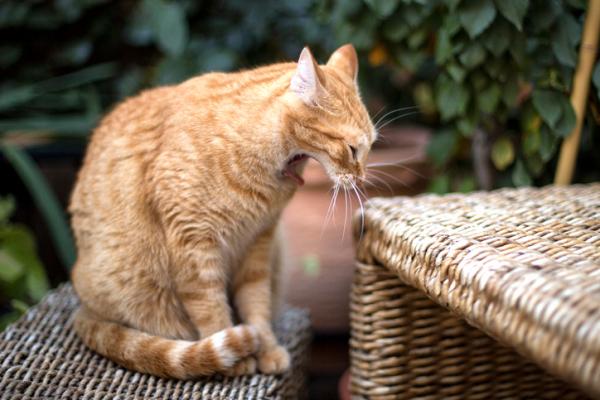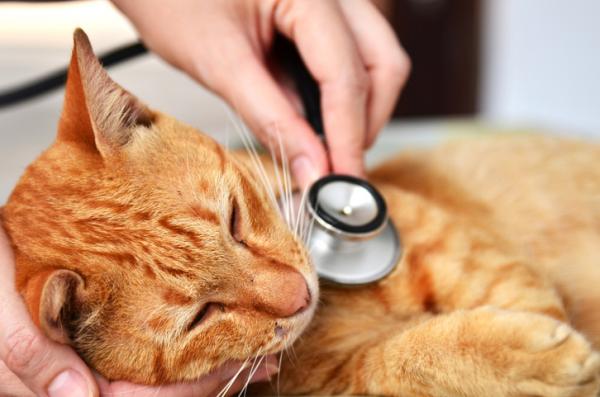Why is my cat drowning?

When a Cat shows signs of drowning Right away we worry and we ask ourselves what is happening to him. In this article we are going to expose the common causes that can cause our cat to drown or, at least, it seems that way. We will analyze the pathologies associated with these choking and we will see what can be done to solve this situation. As always, we recommend consulting with our veterinarian, as it is the professional capable of diagnosing and prescribing the appropriate treatment. However, to reach the well-informed consultation, read on and discover with us why your cat is drowning.
Infections of the upper respiratory tract
This type of infection is very common in cats, although, thanks to the development of vaccination programs, its incidence is decreasing. The causative agents of this group of diseases are, mainly, feline rhinotracheitis virus, calicivirus virus and Chlamydia. They can be associated with bacteria and other organisms that will cause secondary infections. One of the traits that they possess is that they are highly contagious and they are transmitted between cats through their secretions. They are more common in young kittens, patients with leukemia or immunodeficiency or cats who are going through stress situations, such as those who live in animal shelters or hatcheries, or those who have just undergone an operation or disease. By having the immune system compromised, they are not able to resist the pathogen. According to the attacking virus, so will the symptom picture. It is possible that in the same cat there are infections at the same time by several of these agents. In summary, the frequent symptoms They are:
- Recurrent conjunctivitis that may be caused by Chlamydia.
- Ulcers in the mouth and stomatitis, related to the calicivirus.
- Corneal ulcers due to herpesvirus.
- In general, these infections produce nasal secretions, eye, sneezing, fever, lethargy or anorexia. The cat can not smell the food, so it is not swallowed, and it can have ulcers in the mouth that make feeding difficult.
- With regard to the symptom that concerns us, these conditions can cause cough with a choking sensation and open mouth with the tongue out in an attempt to improve breathing. The animal stretches the neck, adopting a characteristic posture, when it seems that the cat is drowning.
This symptomatology is so clear that it is not usually necessary to perform any test. It is recommended to test immunodeficiency and leukemia if the disease occurs recurrently. Since it is a virus, there is no other treatment than support, that is, antibiotics for secondary infections and fluid therapy if necessary, in addition to keeping the animal clean of secretions and fed. The sooner you start treatment, the more chances there are of recovery. Do not forget that these cats, if they are not treated, can end up dying. Still restored, viruses tend to remain dormant in the body and can cause symptoms again in times of immunological compromise.

Feline asthmatic syndrome
Our cat may also appear to drown if he suffers from feline asthmatic syndrome. Asthma produces a bronchoconstriction that causes breathing noises and breathlessness, or breathing difficulties. The symptom They include:
- Cough of gravity and variable frequency.
- Respiratory difficulties and shortness of breath (dyspnea).
- Sometimes, fever, lethargy and anorexia, either secondary bacterial infection, or by choking and cough that make difficult the intake of both liquids and solids.
The diagnosis can be established from the symptoms because there are few diseases that produce dyspnea and cough in cats. The treatment will depend on the severity and frequency of the symptoms and, as always, the veterinarian should prescribe it.
Cough, vomit and hairballs
Sometimes, intense coughing fits in which the cat seems to drown can cause vomiting. In no case should these episodes be confused with vomiting intended to expel hairballs. For cats, eliminating these balls is normal, not pathological, so it is a process that has nothing to do with coughing. We can facilitate the expulsion of the hair balls by supplying products such as malt, which will favor this transit. So, if our cat chokes and coughs, or we notice that the cat is gagging and does not vomit, we should consult with our veterinarian.

This article is merely informative, in .com we do not have the faculty to prescribe veterinary treatments or make any kind of diagnosis. We invite you to take your pet to the veterinarian in case of any type of condition or discomfort.
If you want to read more articles similar to Why is my cat drowning?, we recommend that you enter in our section of respiratory diseases.


